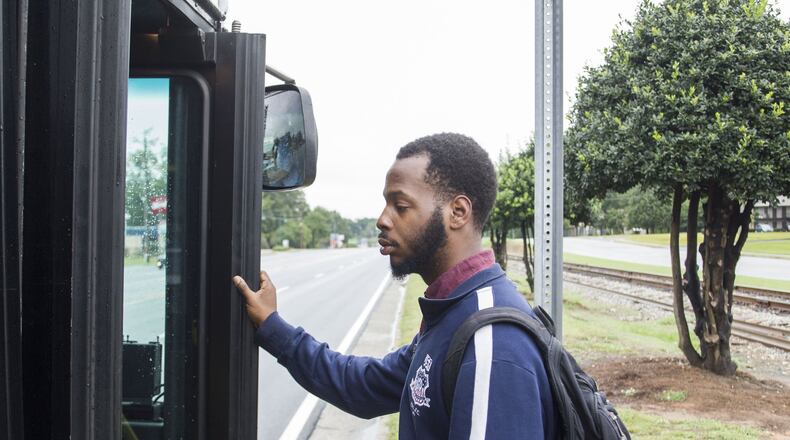DeAngelo Bowie goes to work every day at 1 p.m. at a pet store warehouse and stacks boxes until the work is done. On a good day, he’s out by 9 p.m. On a bad day, he won’t leave until 1 a.m.
He’s trying to figure a way to stretch his meager paycheck to pay back college loans for a degree he never finished.
Bowie navigated a daunting obstacle course of family and health crises during his teenage years and made it to his dream school – Georgia State University. But he left in the middle of his sophomore year, with $12,000 in federal student loans.
In doing so, he joined more than 108,000 other students who withdrew from Georgia’s public colleges and universities between 2013 and 2015 with thousands of dollars in federal student debt but no degree.
RELATED: Georgia holding back millions in lottery funds from HOPE scholarships
These former students have few prospects for good-paying jobs yet the loans they racked up mean earning a decent wage is even more imperative. However, many find themselves working in retail jobs or warehouses, scraping by to make monthly loan payments. And many, like Bowie, may want to go back to school but can’t because they’ve defaulted, or they fear sliding further into debt.
“You’re in purgatory,” said Nicole Smith, vice president of Georgetown University’s Center on Education and the Workforce. “You have this extra burden and debt on you that cannot be written off. Because you don’t have the higher credential, you’re not going to be able to get the job to pay it. It’s a significant problem.”
The issue is particularly acute at Georgia’s research and regional universities, where students typically sign on for higher levels of debt in the hope that a bachelor’s degree will ultimately lead to a higher-paying job. The number of dropouts with federal loans at these institutions grew from 35,443 in 2007-09 to more than 56,600 in 2013-15. In that time the median student debt at most schools more than doubled.
The numbers of students with school debt but no degree are large enough that the financial impact goes beyond individual struggles and weighs on the state’s economy. By 2025, more than 60 percent of Georgia jobs will require some sort of post-secondary degree, and now only 45 percent of residents have one.
Growing up in the Bankhead section of Atlanta, Bowie always saw college as a way out of poverty, not something that would confine him to it further. “I was never unaware that we were poor, and I always thought college was the exit ticket for it,” said Bowie, 24.
Most economists agree that too few residents with college degrees will slow Georgia’s economic growth, which could affect all residents.
“More income means more tax revenue, and generally more educated taxpayers have less demand for state services,” said Professor David Sjoquist, an economics professor at the Andrew Young School of Policy Studies at Georgia State. “The kinds of jobs that are growing are the kinds that require more education, so if we had more residents with those degrees, they would find jobs.”
In comparison, people with some college make less than their peers with degrees, and they have higher unemployment rates, according to Bureau of Labor statistics. Median weekly earnings for people with some college was $756 in 2016, compared to $1,256 for those with a bachelor's degree.
The top 20 occupations with the highest projected decline in Georgia require some college or below, while the top four with the highest growth require at minimum an associate’s degree, according to the Georgia Department of Labor.
Georgia's higher education system is, compared with other states, moderately priced – the state's four-year universities' average tuition and fees ranked 19th in the nation in affordability in 2016-17. But it has had some of the biggest cost increases in the country; tuition and fees have more than doubled in the past decade, bumping the state down from sixth most affordable a decade ago.
This summer, Bowie began trying to get back to college, only to find that his $12,000 in loans had been sold to a collection agency. He is in default and has to pay off the bulk of it before he can re-enroll at Georgia State.
“I would have to pick up a second job to make a significant dent in it,” said Bowie, who already works 40 to 50 hours a week. “But I don’t know how I’d do it. Some days I’m lucky if I have time to get up and have breakfast before it’s time to go back to work.”
Repayment rates for loans are lower for students who withdraw from college compared to those who graduate, according to federal data. Dropouts make up nearly two-thirds of defaults nationwide.
Nearly all of the college dropouts interviewed by the AJC were either working in low-paying hourly jobs or had started their own businesses. That’s typical, said Smith of the Center on Education and the Workforce.
“The prospects there are very difficult,” Smith said. “You are competing in a declining labor market.”
Most students who leave school don’t make it back. A study of the California State University system found that only 30 percent of students who drop out re-enroll at their original college.
If Bowie is able to buck this trend and be successful, he’d not only be helping out his family but the state. A job projection report from the Georgia Department of Labor predicts that the need for teachers will rise in the state by 2020, along with other positions such as accountants, software developers and registered nurses. Nationwide, jobs that require a bachelor’s degree or higher have grown by 8.4 million during the economy’s recovery.
If Georgia’s universities can’t supply those workers, businesses might look to hire people from out of state, meaning upward mobility for Georgia’s low-income residents will stagnate. Or they could hire unqualified workers and train them in-house – which could harm productivity and drive away companies considering relocating to Georgia, Smith said.
In 2011, Georgia launched an effort to tackle this issue called Complete College Georgia. The work began with a $1 million grant from the Complete College America Foundation, a national organization that works with states to improve graduation rates.
As part of this program, each institution has to develop annual strategies to retrain and graduate students, such as shortening the amount of time it takes students get a degree, improving agreements between two- and four-year schools so credits transfer more easily and placing fewer students in remedial courses during their first semester. The system has started a program called Go Back, Move Ahead to get adults to return to school by making it easier to enroll and offering flexible course schedules. In some cases, people can also use military or volunteer experience to earn credits.
In 2011, the University System of Georgia had a 74 percent first-year retention rate. In 2016 it was 79 percent. Graduation rates, however, have not had a similar improvement; six-year graduation rates at the state’s universities remain at 57 percent.
Retention rates at the Technical College System have stayed around 67 percent since 2011, but graduation rates are up from 54 percent to 70 percent. But fewer people are enrolled in technical schools, meaning the system conferred about 3,000 fewer degrees, diplomas and certificates in 2016 than 2011.
Officials agree that the stability of Georgia’s economy hinges on the success of Complete College Georgia. As Gov. Nathan Deal put it in 2012, six months after the launch of the program: “To have a successful future in Georgia, and remain competitive nationwide and globally, we have to have an educated workforce, and that means we need to do a better job getting people into college, make sure they receive a high-quality education and then graduate them.”
Bowie says he won’t give up on his dream of returning to school and becoming a teacher. Many students share similar sentiments, and some Georgia college administrators refer to them as “stopping out” rather than dropping out.
He has incentive. In 2015, his stepfather, who had been a steadying force in the family, dropped dead from a heart ailment. “It was like losing two legs off a chair,” Bowie said.
His mom and four siblings were evicted and became homeless, living in temporary housing in a motel for ten months. Last fall, she was able to get enough together to rent a house and keep the family together. Bowie respects his mother’s tenacity and devotion to her family, but he says he knows that her lack of a degree has held her back.
“My mom graduated a year early from high school,” said Bowie. “She’s really smart, but she never went to college. I feel like it’s history repeating itself.”
He said if he could clear his loans and get some financial assistance, he knows he could make it.
“I would put my focus on school,” he said, staring out into the parking lot in front of his house. “I would want A’s, just because I know what I can do. If I could actually put in the effort, I know could graduate with honors.”
About this article
This is the second of a three-part series by The Hechinger Report in collaboration with The Atlanta Journal-Constitution.
The first installment last Sunday looked at student debt and HOPE scholarships in Georgia and can be read at myAJC.com/HOPE. The final installment, looking at the financial gap between HOPE scholarships and the full cost of college and how that affects Georgian families and the state economy, will appear in Sunday's AJC.
This story was produced by The Hechinger Report in a collaboration with The Atlanta Journal-Constitution. The Hechinger Report is a nonprofit, nonpartisan news organization focused on inequality and innovation in education. It receives support from a variety of individuals and philanthropies and works with news organizations across the country. Learn more at hechingerreport.org.
Keep Reading
The Latest
Featured

